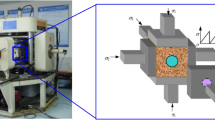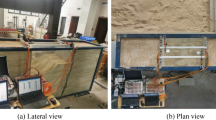Abstract
Two full-scale experiments using controlled blasting were conducted in the Port of Tokachi on Hokkaido Island, Japan, to assess the behavior of piles and pipelines subjected to lateral spreading. Test specimens were extensively instrumented with strain gauges to measure the distribution of moment during lateral spreading. This allowed us to compute the loading condition, as well as to conduct damage and performance assessments on the piles and pipelines. This paper presents the test results and discussions on the response of single piles and pipelines observed from the full-scale experiments. Based on the test results, it can be concluded that using controlled blasting successfully liquefied the soil, and subsequently induced lateral spreading. The movements of the single pile, as well as the transverse pipelines, were approximately the same as the free field soil movement. Observed moment distribution of the single pile indicated that global translation of the liquefied soil layer provided insignificant force to the pile. In addition, the degree of fixity at the pile tip significantly affected the moment along the pile as well as the pile head displacement. The pile with a higher degree of fixity at the pile tip had smaller pile head displacement but larger maximum moment.
Similar content being viewed by others
References
Abdoun TH, Dobry R, O’Rourke TD and Chaudhuri D (1996), “Centrifuge Modeling of Seismically-induced Lateral Deformation During Liquefaction and Its Effect on a Pile Foundation,” Proc. Sixth Japan-U.S. Workshop on Earthquake Resistant Design of Lifeline Facilities and Countermeasures against Soil Liquefaction, Technical Report NCEER-96-0012, NCEER, SUNY-Baffalo, NY, pp. 525–539.
Ashford SA, Rollins KM, Bradford SC, Weaver TJ and Baez JI (2000), “Liquefaction Mitigation Using Stone Columns Around Deep Foundations: Full-scale Test Results,” Soil Mechanics 2000, Transportation Research Record No. 1736, TRB, Washington D.C., pp.110–118.
ASTM Standard (1998), Annual Book of ASTM Standards, Vol. 04.09, West Conshohocken, PA, pp. 217–227.
Bartlett SF and Youd TL (1992), “Empirical Analysis of Horizontal Ground Displacement Generated by Liquefaction-induced Lateral Spreads,” Tech. Rep. NCEER-92-0021, National Center for Earthquake Engineering Research, Buffalo, N.Y., Hamada M. and O’Rourke TD(eds.), August 17.
Benuzca L (1990), “Loma Prieta Earthquake Reconnaissance Report”, Report by EERI and NRC, Supplement to Vol.6 of Earthquake Spectra, May, 448 p.
Dobry R and Abdoun TH (2001) “Recent Studies on Seismic Centrifuge Modeling on Liquefaction and Its Effect on Deep Foundations,” State-of-the-Art Paper, Proc. 4th Intl. Conf. on Recent Advances in Geotechnical Earthquake Engineering and Soil Dynamics and Symposium to Honor Prof. W.D.L. Finn (S. Prakash, eds.), San Diego, CA, March 26–31, SOAP-3, Vol. 2., pp.1–30.
Hamada M (1992a), “Large Ground Deformations and Their Effects on Lifelines: 1964 Niigata Earthquake,” Ch.3 of Case Studies of Liquefaction and Lifeline Performance during Past Earthquakes, Report No. NCEER-92-0001, Vol.1, (Hamada and O’Rourke, eds.) National Center for Earthquake Engineering Research, Buffalo, N.Y, pp. 3–1 to 3–123.
Hamada M and O’Rourke T (1992b), “Case Studies of Liquefaction and Lifeline Performance During Past Earthquakes,” Report No. NCEER-92-0001, Vol.1, National Center for Earthquake Engineering Research, Buffalo, N.Y.
Hamada M (2000), “Performance of Foundations Against Liquefaction-induced Permanent Ground Displacement,” Proc. 12th World conference on Earthquake Engineering, Auckland, New Zealand, Paper No. 1754.
Japanese Geotechnical Society (1995), Method for Swedish Weight Sounding Test (JIS A 1221-1995), Ground Survey Method, pp.213–220 (in Japanese)
Meneses J, Hamada M, Kurita M and Elgamal A (2002), “Soil-pile Interaction Under Liquefied Sand Flow in 1g Shake Table Tests,” Proceedings, International Conference on Advances and New Challenges in Earthquake Engineering Research, August 15–20, Harbin and Hong Kong, China.
O’Rouke TD (1996), “Lessons Learned for Lifeline Engineering from Major Urban Earthquakes,” Proceedings, Eleventh World Conference on Earthquake Engineering, Elsevier Science Ltd., 18 p. Port and Harbor Research Institute (1997), Handbook on Liquefaction Remediation of Reclaimed Land, A.A. Balkema, Rotterdam, Brookfield.
Ramos R, Abdoun TH and Dobry R. (2000), “Effect of Lateral Stiffness of Super Structure on Bending Moments of Pile Foundation Due to Liquefaction-induced Lateral Spreading,” Proc. 12th World conference on Earthquake Engineering, Auckland, New Zealand, Paper No. 0902.
Sato Kogyo Co. (2002), (Personal Communication), Japan.
Takahashi Y (2002a), “Consideration of the Measured Action of Piles,” Internal workshop on Full-Scale Lateral Spreading Tests, Japan, June 24–25
Takahashi Y (2002b), “A Result of the Ground Surface Displacement Measured by GPS and an Investigation on the Flowing Characteristics of the Liquefaction Soil,” Internal workshop on Full-Scale Lateral Spreading Tests, Japan, June 24–25.
Tokida K, Iwasaki H, Matsumoto H and Hamasa T (1993), “Liquefaction Potential and Drag Force Acting on Piles in Flowing Soils,” Soil Dynamic and Earthquake Engineering, Computational Mechanics, South Hampton, England, pp. 349–364.
Turner LL (2002), “Application of Real-Time Kinematic Global Positioning System to Measure Liquefaction-Induced Ground Surface Deformations,” thesis presented to University of California, Davis, In partial satisfaction of the requirements for the degree of Master of Science.
Wang L, He K, Shi Y and Wang J (2002) “Study on Liquefaction of Saturated Loess by In-situ Explosion Test,” Journal of Earthquake Engineering and Engineering Vibration, 1(1): 50–56
Wilson DW, Boulanger RW and Kutter BL (2000), “Observed Seismic Lateral Resistance of Liquefying Sand,” J. Geotechnical and Geoenvironmental Engineering, ASCE, 126(10): 898–906.
Youd TL, Rollins KM, Salazar AF and Wallace RM (1992), “Bridge Damage Caused by Liquefaction During the 22 April 1991 Costa Rica Earthquake,” Proc. Tenth World Conference on Earthquake Engineering, Madrid, Spain, July 19–24, pp. 153–158
Author information
Authors and Affiliations
Corresponding author
Rights and permissions
About this article
Cite this article
Ashford, S.A., Juirnarongrit, T. Response of single piles and pipelines in liquefaction-induced lateral spreads using controlled blasting. Earthq. Engin. Engin. Vib. 1, 181–193 (2002). https://doi.org/10.1007/s11803-002-0064-3
Issue Date:
DOI: https://doi.org/10.1007/s11803-002-0064-3




